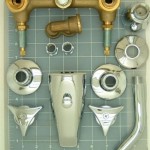How To Keep a Dog in the Bathtub: A Comprehensive Guide
Bathing a dog can often present challenges, particularly when attempting to confine the animal within the bathtub. Many dogs demonstrate a natural aversion to being bathed, leading to struggles and potential escape attempts. Understanding the underlying reasons for this reluctance, and employing effective strategies, are crucial for a successful and stress-free bathing experience for both the dog and the owner. This article provides a detailed guide on how to keep a dog in the bathtub during bath time, focusing on techniques that promote cooperation and minimize anxiety.
Understanding the Reasons for Resistance
A dog's reluctance to stay in the bathtub can stem from various factors. It is important to consider these underlying causes to tailor the approach and mitigate the dog's anxiety effectively. Identifying the root cause is the first step in creating a more positive bath time experience.
Firstly, many dogs are simply unfamiliar or uncomfortable with the bathtub environment. The smooth, slick surface can feel unstable and precarious, triggering a fear of slipping or falling. The enclosed space, combined with the sound of running water, can also be overwhelming, especially for dogs sensitive to noise or those with claustrophobic tendencies. A bathtub may also conjure negative associations due to past unpleasant bath experiences.
Secondly, the bathing process itself can be perceived as unpleasant. The feeling of being wet, the temperature of the water, and the sensation of shampoo can all contribute to a dog's aversion. Harsh scrubbing or getting soap in the eyes can further exacerbate the negative associations. Moreover, being restrained or handled in a way that feels uncomfortable can trigger a defensive response, leading to struggling and attempts to escape.
Thirdly, a lack of proper socialization and habituation to bathing during puppyhood can contribute to resistance later in life. If a dog is not gradually introduced to the sights, sounds, and sensations of bath time at a young age, it is more likely to develop anxiety and aversion as an adult. Early, positive experiences are crucial for shaping a dog's perception of bathing and fostering a more cooperative attitude. A positive association can start with just getting the dog in the tub with no water to just associate the space with treats.
Creating a Positive Bathing Environment
Transforming the bathtub into a more welcoming and comfortable space is key to reducing a dog's anxiety and increasing its willingness to stay put. This involves addressing the factors that contribute to discomfort and creating a more secure and enjoyable experience.
First and foremost, the bathtub's surface should be treated to minimize slipperiness. Placing a non-slip mat or towel on the bottom of the tub provides traction and stability, preventing the dog from feeling insecure and anxious about slipping. This simple measure can significantly improve a dog's confidence and reduce the likelihood of struggling.
Water temperature plays a crucial role in a dog's comfort. The water should be lukewarm, neither too hot nor too cold, to avoid causing discomfort or distress. Testing the water temperature with a hand to ensure it is comfortable for human skin is a good way to gauge its suitability for a dog. Consistent temperature avoids discomfort and creates a more reliable association with bath time.
The bathing environment's overall ambiance can also impact a dog's anxiety levels. Minimizing loud noises, such as the television or radio, can create a more calming atmosphere. Speaking to the dog in a soothing and reassuring voice can also help to alleviate anxiety and promote a sense of security. Using a gentle, calm tone can make a significant difference in the dog's demeanor. Positive reinforcement, such as offering treats or praise, can further enhance the positive associations with bath time.
Introducing the dog to the bathtub gradually, rather than forcing it into the situation, can also be beneficial. Start by simply allowing the dog to explore the dry bathtub, rewarding it with treats and praise for positive interactions. Slowly introduce the sound of running water, and eventually progress to wetting the dog's paws. This gradual approach allows the dog to become accustomed to the bathtub and the bathing process at its own pace, reducing anxiety and promoting a more cooperative attitude. It's important to be patient and avoid pushing the dog beyond its comfort level.
Employing Restraint and Distraction Techniques
While the goal is to create a positive bathing experience, there may be instances where gentle restraint is necessary to prevent the dog from escaping. However, restraint should always be used in a humane and compassionate manner, focusing on minimizing anxiety and maximizing comfort. Distraction techniques can also be employed to keep the dog engaged and focused on something other than the bathing process.
A leash can be used to provide a gentle form of restraint, preventing the dog from jumping out of the bathtub while still allowing it to move and adjust its position. The leash can be attached to a secure fixture near the bathtub, such as a showerhead or a towel rack. It is crucial to ensure that the leash is not too tight, allowing the dog sufficient freedom of movement while preventing escape. The leash should be used as a guide, not a tool for forceful constraint. Furthermore, never leave a leashed dog unattended in the bathtub.
Distraction techniques can be highly effective in diverting a dog's attention away from the bathing process. Licking mats, which are rubber mats with textured surfaces designed to hold soft food, can provide a long-lasting and engaging distraction. Spreading peanut butter or other dog-safe treats onto the mat can keep the dog occupied for an extended period, making the bathing process less stressful and more manageable. Puzzle toys that dispense treats can also serve as a valuable distraction, engaging the dog's mind and preventing it from focusing on the bath.
Another effective distraction technique is to use a handheld sprayer to deliver a gentle stream of water while simultaneously providing positive reinforcement. By focusing on the sensation of the water and the attention of the owner, the dog may be less likely to resist the bathing process. The water pressure should be gentle and consistent, avoiding sudden bursts that could startle the dog. A soft washcloth can also be used to gently massage the dog's fur while rinsing, providing a comforting sensation and further distracting it from the bath.
Speak to the dog in a calm, reassuring voice throughout the bathing process, offering praise and encouragement. A soothing tone can help to alleviate anxiety and promote a sense of security. Avoiding harsh commands or raised voices is essential, as this can exacerbate the dog's fear and resistance. Positive reinforcement, such as offering treats or verbal praise, should be consistently employed to reward cooperative behavior. The timing of the rewards is crucial; providing a treat immediately after a positive action, such as standing still or allowing the owner to wash its face, reinforces the desired behavior and increases the likelihood of future cooperation.
If the dog becomes overly stressed or anxious, it is important to stop the bathing process immediately. Forcing a dog to endure a stressful experience can create negative associations with bathing, making future attempts even more challenging. Instead, end the bath on a positive note by offering a treat and plenty of praise. Then, reassess the approach and identify areas for improvement before attempting another bath. Breaking the bathing process into shorter sessions can also be beneficial, allowing the dog to gradually become accustomed to the experience without feeling overwhelmed.

Should You Be Bathing Your Dog In The Bathtub Luna Spas
7 Tips For Giving Your Dog A Bath In The Tub

Diy Dog Wash Station

How To Get Your Dog Love Baths Towel

5 Tips For Keeping Your Pup In The Bathtub During Bath Time Vetericyn

Tips For Bathing A Dog That S Baths

The Best Way To Give Your Dog A Bath At Home Oakland Veterinary Referral Services

How To Bathe A Dog The Right Way According Pet Expert Trusted Since 1922

Dog Bathing 101 Everything To Know About Keeping Your Clean

7 Diy Dog Bath Tubs You Can Make Today With Pictures Dogster
Related Posts








